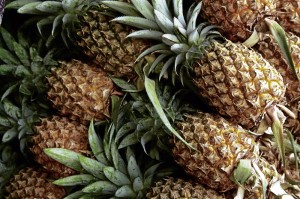Families survive by selling the ‘Queen’

CAMARINES Norte residents claim the Queen pineapples are the sweetest in the world. JONAS CABILES SOLTES
DAET, Camarines Norte—For Edna Retona, a 48-year-old mother of three, the sweet, juicy Queen pineapple of Camarines Norte is more than just refreshment or dessert; it allows her to make both ends meet and send the children to school.
Every two days for the past five years, Retona has sold at most 500 pineapples of the Queen variety on a roadside open stall at the public market of Daet, the provincial capital. The place has been teeming with traders selling almost every kind of merchandise.
The people of Camarines Norte are wont to proclaim that the Queen is the sweetest in the world.
“I earn enough from it. I would have not carried on with this hard task of peeling pineapples if I were not getting anything from it,” says Retona, a resident of Barangay V in Daet.
The woman has been the sole family breadwinner since her husband became ill more than a year ago.
Article continues after this advertisementIn 2007, she started selling pineapples with a capital of just P500. Now, she is one of the biggest sellers in the public market.
Article continues after this advertisement“I had been selling small pineapples I bought from other sellers in the market until I got to know planters from San Lorenzo Ruiz who have been directly supplying pineapples of commercial quality,” she says. Since then, her income has grown steadily.
Retona sells two pineapples for P25 and peeled pineapple for P15. She buys the fruits from suppliers for P7 each.
Peak season is the summer months, when she would net P1,000 a day. During the rainy days, she would earn only P700 while the shelf life of pineapple would drop from one week.
Art of peeling
She saves at least P50 from her daily earnings for the rainy days or when the supply of pineapples runs out, especially during fiestas.
Retona has so mastered the art of peeling pineapples that she can even think of other things.
Peeling should start by slicing the fruit crosswise on top, near the stalk, so the extent of the “eyes” on the flesh of the fruit would be determined, she says. “That knowledge helps when it is time to remove the eyes by cutting a spiral gully around the pineapple,” she says.
By selling pineapples, she says she can send her daughter to college next year until she earns a degree. She is determined to do the same for her two other children, who are in elementary school.
“Many of the pineapple sellers in Daet have sent their children to college. I will do the same. I will do everything,” she says.
Enough supply
Retona and other pineapple sellers in Daet and in other towns have been given assurance by the government that they will have enough supply in the coming years.
According to the Department of Agriculture, Camarines Norte remains one of the top producers of pineapple in the country. In 2003, it produced 87,060 metric tons.
